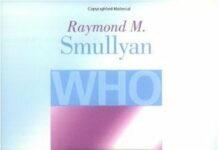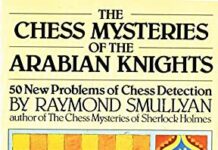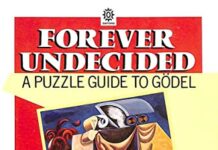
Ebook Info
- Published: 2014
- Number of pages: 288 pages
- Format: PDF
- File Size: 5.36 MB
- Authors: Raymond M. Smullyan
Description
Written by a creative master of mathematical logic, this introductory text combines stories of great philosophers, quotations, and riddles with the fundamentals of mathematical logic. Author Raymond Smullyan offers clear, incremental presentations of difficult logic concepts. He highlights each subject with inventive explanations and unique problems.Smullyan’s accessible narrative provides memorable examples of concepts related to proofs, propositional logic and first-order logic, incompleteness theorems, and incompleteness proofs. Additional topics include undecidability, combinatoric logic, and recursion theory. Suitable for undergraduate and graduate courses, this book will also amuse and enlighten mathematically minded readers. 2014 edition.
User’s Reviews
Editorial Reviews: From the Back Cover Written by a creative master of mathematical logic, this introductory text combines stories of great philosophers, quotations, and riddles with the fundamentals of mathematical logic. Author Raymond Smullyan offers clear, incremental presentations of difficult logic concepts. He highlights each subject with inventive explanations and unique problems.Smullyan’s accessible narrative provides memorable examples of concepts related to proofs, propositional logic and first-order logic, incompleteness theorems, and incompleteness proofs. Additional topics include undecidability, combinatoric logic, and recursion theory. Suitable for undergraduate and graduate courses, this book will also amuse and enlighten mathematically minded readers. Dover (2014) original publication. See every Dover book in print atwww.doverpublications.com About the Author Raymond Smullyan received his PhD from Princeton University and taught at Dartmouth, Princeton, Indiana University, and New York’s Lehman College. Best known for his mathematical and creative logic puzzles and games, he was also a concert pianist and a magician. He wrote over a dozen books of logic puzzles and texts on mathematical logic. Raymond Smullyan: The Merry Prankster Raymond Smullyan (1919–2017), mathematician, logician, magician, creator of extraordinary puzzles, philosopher, pianist, and man of many parts. The first Dover book by Raymond Smullyan was First-Order Logic (1995). Recent years have brought a number of his magical books of logic and math puzzles: The Lady or the Tiger (2009); Satan, Cantor and Infinity (2009); an original, never-before-published collection, King Arthur in Search of His Dog and Other Curious Puzzles (2010); and Set Theory and the Continuum Problem (with Melvin Fitting, also reprinted by Dover in 2010). More will be coming in subsequent years. In the Author’s Own Words:”Recently, someone asked me if I believed in astrology. He seemed somewhat puzzled when I explained that the reason I don’t is that I’m a Gemini.” “Some people are always critical of vague statements. I tend rather to be critical of precise statements: they are the only ones which can correctly be labeled ‘wrong.'” — Raymond Smullyan
Reviews from Amazon users which were colected at the time this book was published on the website:
⭐I should begin by noting that I’ve been a fan of Raymond Smullyan’s books for many years now and have bought and enjoyed each volume. Although often described as “puzzle” books (which they are), they are also much more than that as Professor Smullyan uses his puzzles, all of which are normally woven into well-told stories and tales, not only to entertain, but also to teach various aspects of logic. I’ve found all the books to be (very) interesting reads, challenging, and amazingly effective at elevating one’s understanding of some often daunting matters. As an example, one of his books brings one along to the point of actually understanding, in much more than just a “pop-science” way, some of the complexities and implications of Kurt Godel’s work–quite an accomplishment. As a result, when I saw that Smullyan had written a more formal guide to mathematical logic, I quickly availed myself of the opportunity of buying it and digging in. Unfortunately, I became somewhat frustrated for two separate but related reasons, one of which was due simply to having purchased the Kindle edition. The first difficulty is due to a quirk of mine, but one I believe may be shared by others. Often in academic texts about math or the hard sciences problems or exercises are given at the end of chapters which allow one to practice the topics covered in that particular chapter. Most teachers of math generally agree that having the students do a number of such problems is very useful, maybe even essential, to allowing students to gain mastery of the topic in question. I agree with this general attitude or belief. I also believe, however, that doing the exercises should not be essential before moving on to the next chapter. In particular, a number of texts make it necessary to complete some of the final exercises because the answers provide essential information required to be able to understand the following chapters. This is a tendency that I dislike and find both unnecessary and manipulative, even if not intended to be so by the author. Well, Smullyan’s text interposes every few paragraphs or pages within each chapter puzzles, similar to those in his more puzzle-oriented books, that one must complete before one can understand or appreciate the paragraphs that follow. This tendency, even if one is not bothered by such (as I am, at least in more formal, not puzzle, books) slows down the reading of the text, and breaks the flow of study a bit too much for my liking. The other difficulty I had with the text is due to having the Kindle version. In a normal book version, as one dealt with each of the puzzles mentioned above, one could flip to the end of each chapter to check one’s solution with that given by Smullyan, or, by reading the first part of the answer, get a useful hint to how best to solve the puzzle. It would also be easy to flip back and forth readily, should there be the desire or need to do so. With the Kindle, paging forward a large number of screens and then paging back, particularly if one had to do that a number of times for each puzzle/teaching point, becomes definitely burdensome and frustrating. If the desire to keep the puzzles in the text rather than simply explain the points being made by them is strong enough, one could put the answers immediately following each respective puzzle question, thus eliminating the constant flipping back and forth. This work-around, however, would require presumably a good deal of time and money changing the format from the printed version to the e-book version, so I understand why this will probably not happen. Anyway, I remain a fan of Smullyan, and will continue to purchase his books (the solid ones, not any future e-books), but it was frustrating that this one, which I really wanted to learn from, was so difficult and tiring to deal with.
⭐This book could possibly be used as a first course in logic by reading the first few sections of Chapter 5 while reading Chapter 1, but there are so many (beautiful) proofs to the problems in the first four chapters of mathematical background that it would be difficult to comprehend the first four chapters without knowing some logic (or having mathematical maturity) already. For learning logic for the first time a better book would be Patrick Suppes’ Introduction to Logic.If it’s possible for a book on mathematical logic to be a pleasure to read, this book is it though. Professor Smullyan is a great teacher.
⭐Comprehensive and easy-to-understand guide to mathematical logic. A must-have for anybody interested in the subject.
⭐I did not particularly want to adopt his Propositional Logic Axiom System “So” (Chapter 7)I did however find the format of his book highly didactic which includes problem Solutions in the back of each Chapter.Going thru the problems is necessary to digest the subject.
⭐This is another absolutely incredible masterpiece from an absolutely incredible man! Raymond Smullyan is unique unto himself and a one-man show! Every book he produces is a gem. He entertains while teaching and teaches while entertaining. And he effortlessly – modulo intense hard work on the part of the reader – moves from fundamental concepts in logic up to the dizzy heights of mathematical logic as it stands today.Dr. Smullyan is a remarkable man on all levels and a real delight! It is my sincere hope that I will stumble upon him during one of my many sojourns out of this mortal coil that we call ordinary life!
⭐A first rate book on mathematical logic; good to review the subject or as a reference.Includes topics not referenced in text books we used college. Kurt Godel’s work is covered as well as types of logical notation not usually found in older books on the subject. Some links to current findings sand research too. Will become a classic alongside DeLong’s “Profile of Mathematical Logic”.
⭐The master has written the best mathematical logic book ever!! He actually teaches rather than proves how smart he is!!The solutions were very important for understanding the material! I hope he continues to take us on his wonderful Journey!!Thank you Professor Smullyan !! Gale Gray, a most grateful student!!!
⭐An excellent introductory book on logic, advances on issues that should be studied more deeply and well explains the fundamental concepts.
⭐It’s OK,in the sense that I thought I had understood the text until I did Exercises 1 and 2 in Chapter 1. Perhaps another reviewer can help me out here, but Exercise 1 asks us to prove a certain Boolean equation valid using Smullyan’s indexing method. But as far as I can tell, the equation is not valid. (The exercise does not ask us to determine the validity or otherwise of the equation, jut to prove that it is valid). Exercise 2 asks us to use the same method to prove 4 further equations are valid, but only 3 of them seem to be. Nor are the solutions to these exercises given. Perhaps I am wrong, or perhaps misdirection is a normal part of the author’s writing style?
⭐Raymond Smullyan – 95 and still going strong! Genuinely starts at the beginning – and gets farther, with more clarity, than 99% of writer on this topic. As a writer, on a par with Martin Gardner, of Blessed Memory.
⭐I like mathematical logic very much
⭐Very good. Very helpful. Easy to read and to understand.
⭐The book nice and simple in explaining logic
Keywords
Free Download A Beginner’s Guide to Mathematical Logic (Dover Books on Mathematics) in PDF format
A Beginner’s Guide to Mathematical Logic (Dover Books on Mathematics) PDF Free Download
Download A Beginner’s Guide to Mathematical Logic (Dover Books on Mathematics) 2014 PDF Free
A Beginner’s Guide to Mathematical Logic (Dover Books on Mathematics) 2014 PDF Free Download
Download A Beginner’s Guide to Mathematical Logic (Dover Books on Mathematics) PDF
Free Download Ebook A Beginner’s Guide to Mathematical Logic (Dover Books on Mathematics)



